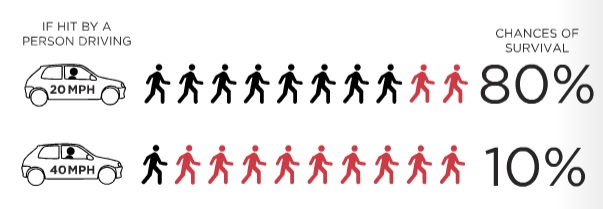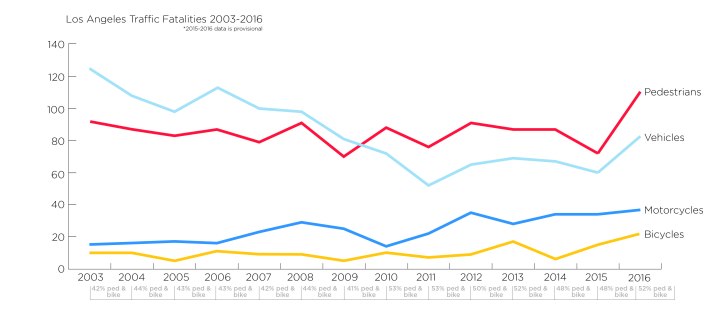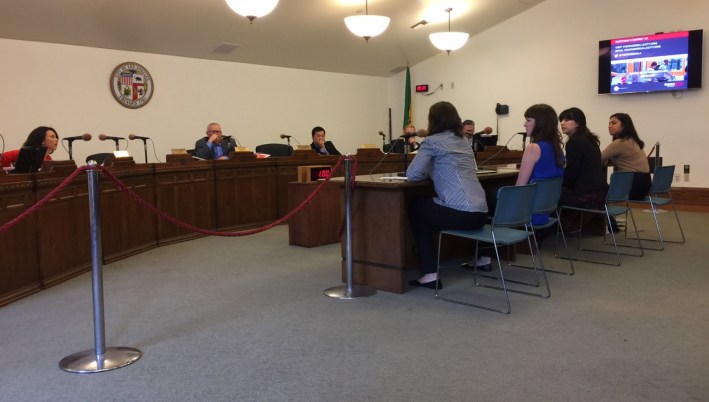Vision Zero Program Struggles To Change L.A. City Priorities
4:50 PM PST on February 8, 2017

LADOT and LAPD are clear on the diagnosis: speeding kills Angelenos. Their prescription is less clear. Chart via LADOT Vision Zero safety study
It was never going to be easy to shift Los Angeles decision-makers' attitudes to care more about keeping people alive than about moving cars. Nonetheless, L.A.'s mayor and city council have approved the city's Vision Zero policy, and directed city departments to work together to, over time, reduce L.A. traffic fatalities to zero.

Unfortunately, the recent trend is worse. 2016 data shows increased fatalities across all road user categories, with pedestrians rising the most steeply in the past year. At today's Transportation Committee meeting, Transportation Department (LADOT) General Manager Seleta Reynolds asserted that the worsening L.A. figures match an overall national trend. Though nobody knows definitively, Reynolds suggests that the recent uptrend is caused by more driving as a result of a good economy and low gas prices, coupled with more distractions. Reynolds was quick to add that only San Francisco and New York City have bucked that national trend, and that those cities have some of the nation's most mature Vision Zero efforts.
Reynolds, along with other LADOT and LAPD representatives, was presenting on the city's recently released Vision Zero Action Plan.
The plan has recently come under criticism from the L.A. County Bicycle Coalition, Biking in L.A. and the L.A. Vision Zero Alliance. LACBC criticizes LADOT's lack of specifics regarding facilities:
[The plan] lacks a clear vision for making the streets safer for people who ride bicycles [and] does not deliver bold goals for expanding the bicycle network... The plan also mentions adding cycle tracks to priority corridors, but nothing of implementation.
Further, the LACBC critiques LAPD enforcement in communities of color:
[T]he City cannot claim to be committed to equity unless it is willing to explicitly address race, racial profiling, and enforcement without racial profiling.
The City’s commitment to unbiased policing falls short in explicitly addressing racial profiling in policing and fails to acknowledge the disproportionate enforcement that is presently aimed at communities of color... An action plan that fails to explicitly, affirmatively, and positively state this is a plan without true vision, honesty, and an ability to take into account the very real realities that people of color in this country face.
The Vision Zero Alliance critique echoes the LAPD profiling point, calling specifically for "adopting a 'no profiling' pledge, as Portland did in its Vision Zero Action Plan" and using a data-driven enforcement approach similar to the San Francisco Police Department’s City Performance Scorecards for “Focus on the Five” reporting, where SFPD specifically prioritizes ticketing the top five offenses that lead to the greatest loss of life.
The Alliance further critiques the lack of city funding behind Vision Zero and the city's failure to address speeding, calling for "a more comprehensive set of actions to address local control of speed limits and the implementation of engineering projects specifically intended to slow traffic."

Unfortunately L.A.'s vision zero plan takes a lot of words and charts to say very little. There is not a lot of there there. When traffic engineers plan highways, the plans say which houses will be torn down and how many lanes will be built. When LADOT plans to reduce traffic fatalities, they list 40 key corridors where something unspecified might happen.
To a large extent, LADOT traffic safety improvements have been hemmed in by several recalcitrant councilmembers who have blocked planned safety improvements. Even in today's meeting, Councilmember David Ryu repeatedly expressed more concerns safety projects causing neighborhood cut-through traffic than he did about loss of life.
If the city's vision zero plan and LADOT's facility engineering strategies sound non-committal, the LAPD's non-efforts are worse. LAPD representatives spoke in platitudes about safety being a department wide priority, community outreach, and bias-free policing. LAPD pledged to provide more data to LADOT (though not necessarily to the public) in the future when the department upgrades its records management system in a couple months.
Committee chair councilmember Mike Bonin did a noble job of pressing LADOT and LAPD to commit to real action to save lives threatened by traffic violence. Under Bonin's direction, city vision zero efforts will return to the Transportation Committee in 60 days for additional reporting, including:
- LADOT reporting back on project implementation, funding needs and community engagement
- LAPD reporting on adopting programs similar to SF's Focus on the Five and Portland's "no profiling" pledge
(On February 9, this article was corrected to indicate that the Vision Zero plan was not solely developed by LADOT, but by multiple city departments.)
Read More:
Stay in touch
Sign up for our free newsletter
More from Streetsblog Los Angeles
Eyes on the Street: New Lincoln Park Avenue Bike Lanes
The recently installed 1.25-mile long bikeway spans Lincoln Park Avenue, Flora Avenue, and Sierra Street - it's arguably the first new bike facility of the Measure HLA era
Brightline West Breaks Ground on Vegas to SoCal High-Speed Rail
Brightline West will be a 218-mile 186-mile-per-hour rail line from Vegas to Rancho Cucamonga - about 40 miles east of downtown L.A. - expected to open in 2028




